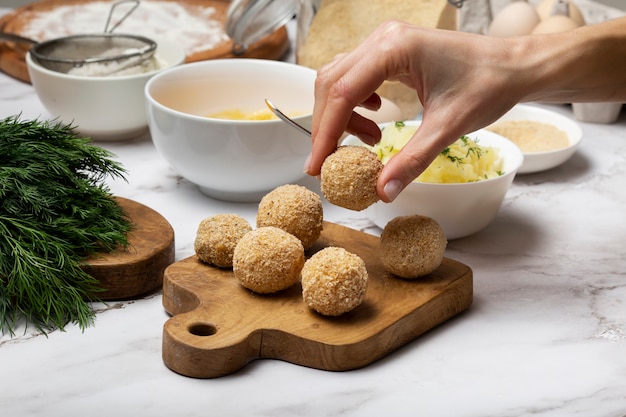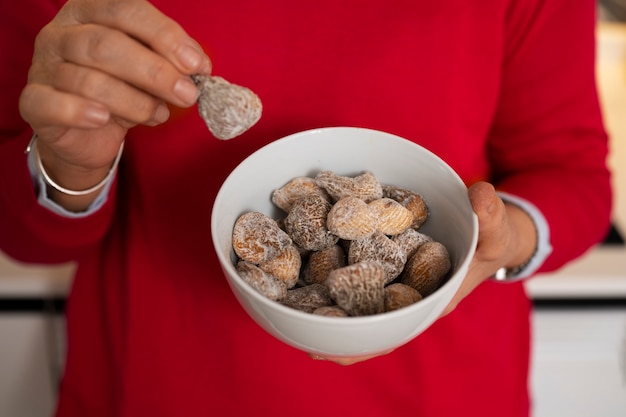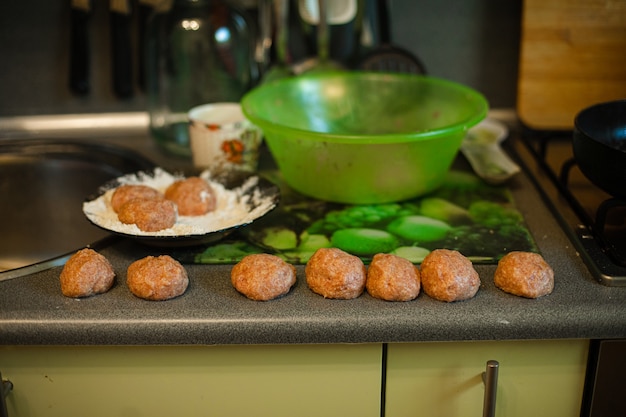Ah, meatballs. Just the word conjures up images of cozy evenings, family gatherings, and the irresistible aroma of simmering sauce. They’re a classic comfort food, versatile enough to grace a fancy dinner table or a casual weeknight meal. But getting those meatballs just right, perfectly cooked, juicy, and bursting with flavor, can feel like a culinary mystery, especially when you're baking them.
Now, I’ve spent countless hours in the kitchen, experimenting with different recipes and techniques, and I’ve learned a thing or two about achieving that magical meatball moment. It’s not just about the recipe, but about understanding the science of heat and how it affects the meat itself. It's about knowing the right temperature, the ideal cooking time, and even how to tell if those meatballs are truly done.
So, grab your apron, gather your ingredients, and let's embark on a culinary journey together. I'm going to share everything I know about baking meatballs at 350°F, including a detailed guide to cooking times based on the size of your meatballs. And trust me, by the end of this, you'll be whipping up delicious, oven-baked meatballs like a pro!
(Part 1) The Magic of 350°F

Why 350°F? Because it’s the Goldilocks temperature for baking meatballs – not too hot, not too cold, but just right. This moderate heat allows the meatballs to cook slowly and evenly, ensuring they're thoroughly cooked without becoming dry and tough. It also helps achieve that beautiful golden-brown crust we all crave, adding a delightful textural contrast and enhancing the flavor.
The Science Behind the Heat
Let's get a little technical for a moment, shall we? When you bake meatballs at 350°F, the heat penetrates the meat, causing the proteins to firm up, a process known as coagulation. This gives the meatballs structure and prevents them from falling apart. Simultaneously, the fat in the meat starts to render, releasing its flavor and adding moisture. This gentle, even heat of the oven allows these processes to happen gradually, resulting in meatballs that are both tender and juicy.
(Part 2) The Meatball Size Factor

Now, here's where things get a bit more specific: the size of your meatballs significantly affects how long they need to bake. It’s simple logic, really – the bigger the meatball, the longer it takes for the heat to reach the center. I've developed a detailed guide to help you estimate the perfect cooking time for different meatball sizes, so you can avoid undercooked or overcooked disasters.
Meatball Size and Baking Time Guide
| Meatball Size (Diameter) | Approximate Baking Time (350°F) | Notes |
|---|---|---|
| Small (1-inch) | 15-20 minutes | Perfect for appetizers or quick meals. |
| Medium (1.5-inch) | 20-25 minutes | A good all-around size for most recipes. |
| Large (2-inch) | 25-30 minutes | Ideal for hearty meals or when you want larger servings. |
| Extra Large (2.5-inch or larger) | 30-35 minutes or more | For larger meatballs, add 5-10 minutes to the baking time for every extra half-inch of diameter. |
Remember, these are just estimations, and your oven might cook a little differently. Always check the internal temperature of your meatballs with a meat thermometer to ensure they're fully cooked. Aim for an internal temperature of at least 160°F for safety.
(Part 3) The Art of Baking

Alright, now that we've got the basics down, let's get those meatballs into the oven! Here’s my tried-and-true approach, designed to produce consistently perfect results:
Step-by-Step Baking Instructions
- Preheat Your Oven: This is crucial. A preheated oven ensures that the meatballs cook evenly, so don’t skip this step! Preheat your oven to 350°F.
- Prepare Your Baking Dish: Use a baking sheet or a shallow casserole dish. Line it with parchment paper for easy cleanup. This also prevents sticking and makes for a smoother experience.
- Form Your Meatballs: Gently form your meatballs using your hands. You want them firm enough to hold their shape during baking, but not so tightly packed that they become tough.
- Arrange on the Baking Dish: Arrange the meatballs in a single layer on the prepared baking dish. Don't overcrowd them. This allows for even airflow and ensures all the meatballs cook evenly.
- Bake Until Cooked Through: Place the baking dish in your preheated oven at 350°F and bake for the time recommended based on the size of your meatballs. Remember to check the internal temperature with a meat thermometer after the minimum cooking time to ensure they're cooked through.
- Let Rest: Once cooked, carefully remove the meatballs from the oven and let them rest for a few minutes before serving. This allows the internal temperature to stabilize and helps the meatballs retain their moisture.
(Part 4) The Secret to Moist and juicy meatballs
We've established that 350°F is the sweet spot for even cooking, but how do we ensure those meatballs are juicy and flavorful? Here's where the art and science of meatball making really come into play.
Tips for Juicy Meatballs
- Choose the Right Meat: Lean ground beef can be prone to drying out, so I often mix it with ground pork or ground veal. The fat content from these meats helps keep the meatballs moist and adds a richer flavor.
- Don't Overwork the Meat: Overmixing the meat can make the meatballs tough and dense. Gently combine the ingredients until they're evenly mixed. Don’t overwork the mixture.
- Add Moisture: I love using breadcrumbs, grated Parmesan cheese, and an egg in my meatball recipe. These ingredients add flavor and bind the meat, helping to retain moisture and prevent the meatballs from becoming dry.
- Avoid Overcooking: Overcooked meatballs are a culinary tragedy! Check the internal temperature with a meat thermometer to ensure they're cooked through but not overdone.
(Part 5) The Importance of Internal Temperature
I know, I know, using a meat thermometer might seem like an extra step. But trust me, it's a simple and foolproof way to guarantee your meatballs are cooked through and safe to eat. You can find inexpensive meat thermometers at most kitchen stores.
How to Use a Meat Thermometer
Simply insert the thermometer into the thickest part of a meatball, making sure it doesn't touch any bone. Wait for a few seconds for the temperature to register.
Safe Meatball Temperature
As mentioned earlier, the internal temperature of your meatballs should reach at least 160°F. This ensures that any harmful bacteria are destroyed, giving you peace of mind while enjoying your delicious creation.
(Part 6) Beyond the Basics: Flavoring Your Meatballs
Now, let's move beyond the fundamentals and get into the fun stuff: flavor! There are endless possibilities when it comes to flavoring your meatballs. I love to experiment with different herbs, spices, and sauces.
Flavoring Ideas
- Italian Herbs: A classic combination of oregano, basil, garlic, and parsley adds a vibrant and aromatic flavor.
- Mediterranean Spices: Cumin, coriander, and paprika add a warm and earthy flavor, transporting your taste buds to sun-drenched shores.
(Part 7) Serving Up Meatball Magic
You've baked your meatballs to perfection, and now it's time to serve them up! But let's go beyond the usual spaghetti and marinara. I've got some creative serving ideas to tantalize your taste buds and inspire your culinary creativity.
Creative Serving Ideas
- Meatball Subs: Serve your meatballs on toasted hoagie rolls with your favorite sauce, cheese, and toppings. This creates a satisfying and delicious sandwich, perfect for a quick lunch or casual dinner.
- Meatball Skewers: Skewer meatballs with cherry tomatoes, bell peppers, and onions. These colorful and flavorful skewers are perfect for parties or summer gatherings.
- Meatball Soup: Add meatballs to a hearty soup with vegetables, beans, and pasta. This warm and comforting soup is perfect for a chilly evening.
- Meatball Appetizer: Serve meatballs with toothpicks as a party appetizer. These bite-sized meatballs are sure to be a hit with your guests.
- Meatball Salad: Toss meatballs with your favorite salad greens, a vinaigrette dressing, and crumbled feta cheese. This light and flavorful salad is a perfect summer meal.
(Part 8) The Sweet Taste of Success
You know, there's something truly satisfying about baking a batch of meatballs and seeing them emerge from the oven, perfectly golden brown and smelling divine. It's a simple dish, but it has the power to bring people together, sharing a delicious meal and creating lasting memories.
So, the next time you're craving a comforting meal, remember the magic of oven-baked meatballs. With a little practice and the tips I've shared, you'll be whipping up delicious and perfectly cooked meatballs in no time. And, who knows, you might even discover your own secret ingredient or serving idea, adding your personal touch to this classic culinary delight. Happy baking!
FAQs
1. Can I bake meatballs at a higher temperature?
While you can bake meatballs at a higher temperature, like 400°F, it will shorten the cooking time and could result in dry meatballs. It's best to stick to 350°F for the most consistent results, ensuring those meatballs are cooked through without becoming tough.
2. What if my meatballs are stuck to the baking sheet?
If your meatballs are sticking, it's likely because the baking sheet isn't properly greased or lined with parchment paper. Next time, make sure to grease the baking sheet with a little oil or line it with parchment paper to prevent sticking and make cleanup a breeze.
3. Can I freeze meatballs before baking them?
Absolutely! You can freeze meatballs before baking them, saving you time and effort in the future. Just place them in a single layer on a baking sheet lined with parchment paper and freeze until solid. Then, transfer them to a freezer-safe bag or container. When you're ready to bake them, thaw the meatballs in the refrigerator overnight and bake as directed.
4. How do I know if my meatballs are fully cooked?
The best way to tell if your meatballs are cooked through is to use a meat thermometer. The internal temperature should reach at least 160°F. If you don't have a meat thermometer, you can cut a meatball in half to check for doneness. The center should be cooked through and not pink.
5. What can I do with leftover meatballs?
There are so many things you can do with leftover meatballs! You can add them to salads, sandwiches, soups, or even use them as a topping for pasta dishes. Get creative and enjoy those delicious leftovers!
Everyone is watching

How to Cook Frozen Lobster Tails Perfectly: A Step-by-Step Guide
RecipesLobster. Just the word conjures up images of lavish meals, special occasions, and a taste of luxury. But let's...

Pigs in a Blanket Cooking Time: How Long to Bake for Perfect Results
RecipesAh, pigs in a blanket. Just the name conjures up images of those delightful little parcels of crispy pastry en...

Pork Fillet Cooking Time: How Long to Cook It Perfectly
RecipesPork fillet, or tenderloin as it's sometimes called, is a real favourite in our house. It's so versatile, and...

The Ultimate Guide to Tender, Juicy Pulled Pork
RecipesRight, let's talk pulled pork. It's one of those dishes that just screams "comfort food," doesn't it? I mean...

The Ultimate Guide to Cooking Sweet Potatoes: From Roasting to Mashing
RecipesSweet potatoes. Just the name conjures up images of warm, comforting dishes, bursts of vibrant color, and a to...
